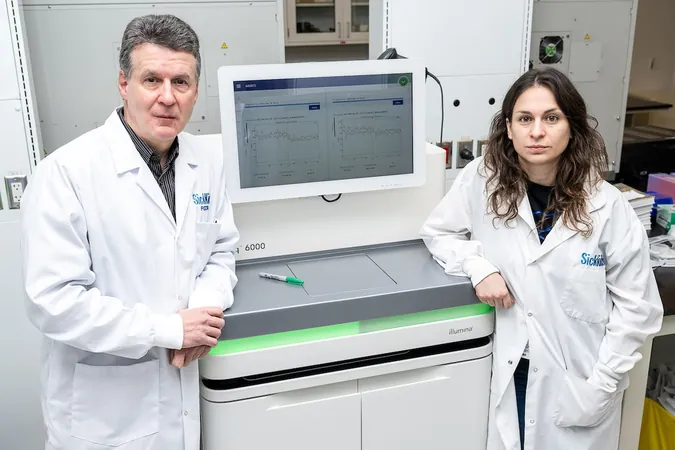
Groundbreaking Discovery Connects New Gene to Boys' Autism Risk: What You Need to Know!
2024-12-22
Author: William
Introduction
In the intricate realm of autism genetics, a groundbreaking discovery has emerged. Researchers have linked a previously unassociated gene, known as DDX53, to autism spectrum disorder (ASD), providing fresh insights into its causes. This gene's location on the human X-chromosome is particularly significant, illuminating why boys are approximately four times more likely to be diagnosed with autism than girls.
Research Insights
Stephen Scherer, chief of research at Toronto’s Hospital for Sick Children (SickKids), who spearheaded the study, remarked, “If you’re male and you don’t have a copy of this gene, you’re likely to be on the spectrum.” This statement reflects the potential role DDX53 plays in the neurodevelopmental challenges faced by boys.
This milestone discovery was unveiled in conjunction with another study published in the *American Journal of Human Genetics*. The second research initiative involved a more comprehensive examination of the X-chromosome and delved deeper into the functional implications of the DDX53 gene in brain development.
Understanding Autism Spectrum Disorder
Autism, also referred to as autism spectrum disorder, is characterized by challenges in social interaction, communication, and learning. Statistically, about 1% of females and 4% of males are affected by ASD. The condition encompasses various subtypes, many linked to rare genetic variants that can impact early brain development.
Long-term Investigation
Dr. Scherer’s two-decade-long investigation into ASD has involved leveraging advanced DNA sequencing techniques to pinpoint genetic markers associated with the disorder. In a landmark 2022 study, his team analyzed the complete genomes of over 7,000 individuals with autism and 13,000 of their family members. This research identified 134 genes that, when altered, could predict autism, yet these accounted for only about 15% of cases, suggesting that numerous genetic pathways remain to be discovered.
Discovery of DDX53 Gene
The revelation of the DDX53 gene's connection to autism came when an Italian colleague observed its effects in several patients with ASD. Though previously overlooked, further analysis confirmed a clear link between DDX53 and autism. In total, researchers identified 10 individuals with ASD affected by this gene, showing similar traits, with all males presenting the disorder’s hallmark characteristics.
Impact of the X-chromosome
The X-chromosome's unique structure poses a higher risk for males, who carry only one copy, as opposed to females, whose second X-chromosome may offer a protective effect against genetic anomalies. This difference emphasizes the need for continued exploration of genetic factors contributing to the gender disparity in autism diagnoses.
Future Research and Implications
The identification of DDX53 is expected to prompt further research, as it resides in proximity to another gene, PTCHD1-AS, known to be associated with autism and cognitive disabilities. The DDX53 gene produces RNA helicase, a protein essential for regulating RNA molecules that control gene expression during development, thereby significantly influencing neurodevelopmental processes.
Dr. Scherer explained, “We believe this acts as a higher-order monitoring system pivotal for the functioning of yet undiscovered genes.” It’s important to note that a single gene variant may not directly cause autism; instead, it might contribute to an increased risk when combined with other genetic or environmental factors.
Additional Findings
The second study conducted by SickKids closely examined the X-chromosome across thousands of individuals with ASD, identifying 17 additional genes that could contribute to the disorder. As expected, both DDX53 and PTCHD1-AS were among the highlighted genes.
Relevance to Families
Myriam Srour, a pediatric neurologist at the Montreal Children's Hospital, who was not directly involved in this research, noted the helpfulness of such findings for families seeking clarity on their child’s ASD. A specific genetic diagnosis can direct families toward effective interventions and foster a sense of community among those facing similar challenges.
Conclusion
As society continues to engage in discussions surrounding autism, heightened by political narratives surrounding health policies, the significance of genetic research cannot be overstated. The revelations regarding the DDX53 gene not only add layers to our understanding of autism but also inspire hope for targeted therapies and interventions that could improve lives.
Stay tuned as more discoveries unfold and illuminate the complex genetics of autism!









 Brasil (PT)
Brasil (PT)
 Canada (EN)
Canada (EN)
 Chile (ES)
Chile (ES)
 España (ES)
España (ES)
 France (FR)
France (FR)
 Hong Kong (EN)
Hong Kong (EN)
 Italia (IT)
Italia (IT)
 日本 (JA)
日本 (JA)
 Magyarország (HU)
Magyarország (HU)
 Norge (NO)
Norge (NO)
 Polska (PL)
Polska (PL)
 Schweiz (DE)
Schweiz (DE)
 Singapore (EN)
Singapore (EN)
 Sverige (SV)
Sverige (SV)
 Suomi (FI)
Suomi (FI)
 Türkiye (TR)
Türkiye (TR)